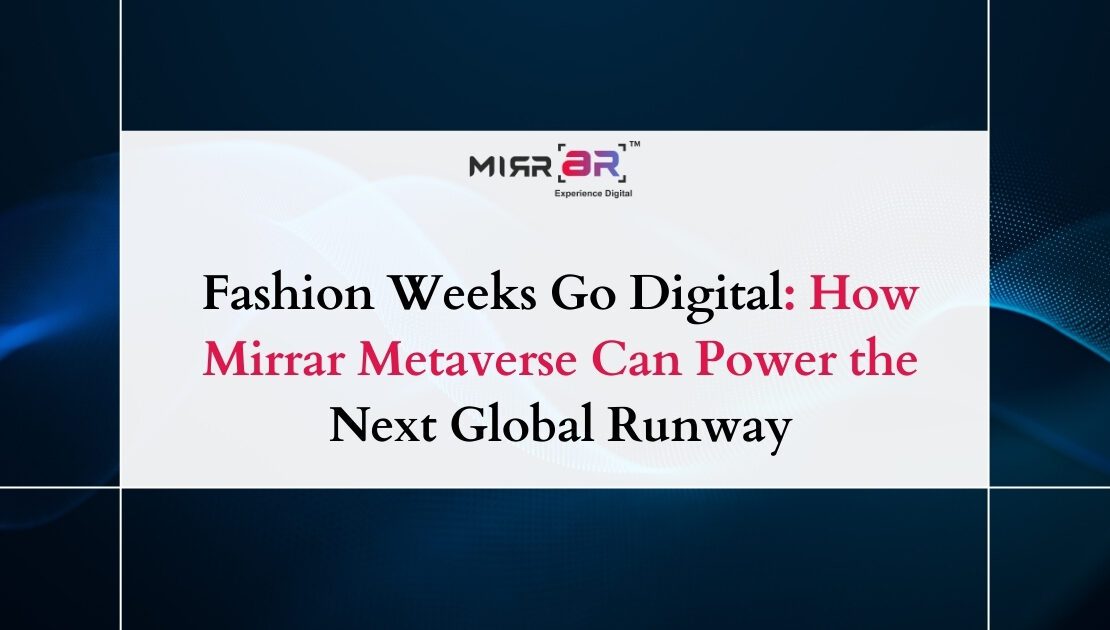
Fashion weeks have always been about more than just clothing; they are cultural events that showcase artistry, creativity, and the latest trends. For decades, global runways in cities like Paris, Milan, New York, and London have defined the future of style. But the traditional format has its limitations—exclusive venues, limited seating, travel barriers, and environmental costs of large-scale events. In today’s digital-first era, these challenges are opening doors to new possibilities, with technology stepping in to rewrite the rules of fashion showcases.
Enter the metaverse—a space where creativity meets connectivity, and where platforms like Mirrar are redefining how fashion is experienced. By blending immersive technologies, Virtual Try-On (VTO), and interactive engagement, Mirrar Metaverse is paving the way for fashion weeks that transcend borders and limitations.
The Digital Transformation of Fashion Weeks
The shift towards digital fashion events began out of necessity during the global pandemic, when physical gatherings came to a halt. Designers, brands, and organizers were forced to explore livestreams, virtual presentations, and online showcases. But what started as an adaptation has now evolved into an innovation.
Digital fashion weeks offer inclusivity, reaching global audiences who previously could only follow highlights online. They also cut down costs for brands and reduce the environmental footprint of physical runway events. However, the real game-changer is the potential to elevate these digital experiences into immersive metaverse-powered showcases.
Mirrar Metaverse: A Runway Without Borders
Mirrar’s metaverse platform provides the perfect bridge between fashion’s creative spirit and technological innovation. Imagine stepping into a virtual Paris or Milan runway from the comfort of your living room, wearing your VR headset or simply through a device screen. The front row is no longer limited to celebrities and industry insiders—anyone can be part of it.
Brands hosting shows on Mirrar Metaverse can create immersive venues, from traditional catwalk setups to futuristic digital landscapes. Attendees don’t just watch; they interact. They can zoom in on details of garments, view collections from multiple angles, and even virtually try on pieces using VTO technology. This shift doesn’t dilute the magic of fashion weeks—it amplifies it.
Virtual Try-On: From Runway to Wardrobe
One of the most powerful features that Mirrar brings to digital fashion weeks is seamless Virtual Try-On integration. Traditionally, audiences could admire collections but not experience them personally until months later, once pieces reached stores. In the metaverse, that timeline collapses.
Viewers watching a showcase can instantly see how a dress, accessory, or piece of jewelry looks on them through VTO. This creates an immediate emotional connection, translating runway inspiration into real-time purchasing decisions. For designers and brands, it bridges the gap between show and sales, turning runway buzz into measurable revenue.
Enhancing Accessibility and Inclusivity
Traditional fashion weeks often carry an aura of exclusivity—tickets are scarce, front-row access is reserved, and entry is limited. With Mirrar Metaverse, the runway becomes truly global and inclusive. Fashion lovers in smaller cities, students studying design, or consumers passionate about style can all take part in the same immersive experience.
Inclusivity also extends to personalization. VTO technology allows users of different body types, skin tones, and personal preferences to see how designs resonate with them individually. Fashion weeks can thus move away from one-size-fits-all presentations to a more democratized, consumer-centric approach.
Sustainability and the Future of Runway Events
The fashion industry is under increasing pressure to address sustainability concerns, with traditional events often criticized for their environmental impact. Physical fashion weeks involve extensive travel, elaborate set constructions, and significant resource consumption.
By shifting to Mirrar Metaverse, brands can drastically reduce these impacts while still delivering high-quality experiences. Virtual venues eliminate the need for physical logistics, digital collections minimize waste, and online interactions cut down carbon footprints. This positions digital fashion weeks not just as innovative, but also as responsible and future-ready.
New Avenues for Creativity and Storytelling
In physical shows, creativity is limited by space, logistics, and budget. But in the metaverse, imagination is the only boundary. Designers can craft runways set in surreal dreamscapes, underwater worlds, or cosmic environments—all while showcasing real, purchasable collections.
Mirrar enables fashion houses to use advanced visuals, interactive storytelling, and immersive soundscapes to elevate their brand narratives. This transforms fashion weeks into multisensory experiences, where technology becomes an extension of creativity, not a constraint.
The Business Case for Digital Fashion Weeks
Beyond creativity and accessibility, the Mirrar Metaverse offers strong business advantages. Brands gain access to global audiences, detailed consumer analytics, and real-time engagement data. Every interaction—whether it’s a virtual try-on, click, or purchase—becomes measurable, allowing brands to refine strategies and maximize ROI.
Moreover, digital showcases allow for extended shelf life. Unlike traditional runway events that last minutes, metaverse fashion weeks can be recorded, repurposed, and made accessible on-demand, ensuring that collections stay in the spotlight long after the event ends.
Conclusion: The Next Global Runway is Virtual
Fashion weeks are no longer confined to iconic venues or exclusive circles—they are evolving into digital-first, immersive, and consumer-driven experiences. Mirrar Metaverse stands at the forefront of this evolution, offering the tools to reimagine runways for a borderless, inclusive, and sustainable future.
As hype meets high-tech, fashion weeks powered by Mirrar won’t just showcase trends; they’ll define how the world experiences fashion itself. The next global runway is not in Paris, Milan, or New York—it’s in the metaverse, and it’s open to everyone.
